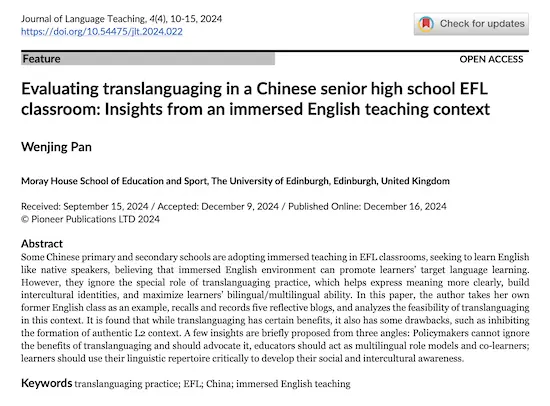Evaluating translanguaging in a Chinese senior high school EFL classroom: Insights from an immersed English teaching context
DOI:
https://doi.org/10.54475/jlt.2024.022Keywords:
translanguaging practice, EFL, China, immersed English teachingAbstract
Some Chinese primary and secondary schools are adopting immersed teaching in EFL classrooms, seeking to learn English like native speakers, believing that an immersed English environment can promote learners’ target language learning. However, they ignore the special role of translanguaging practice, which helps express meaning more clearly, build intercultural identities, and maximize learners’ bilingual/multilingual ability. In this paper, the author takes her own former English class as an example, recalls and records five reflective blogs, and analyzes the feasibility of translanguaging in this context. It is found that while translanguaging has certain benefits, it also has some drawbacks, such as inhibiting the formation of authentic L2 context. A few insights are briefly proposed from three angles: Policymakers cannot ignore the benefits of translanguaging and should advocate it, educators should act as multilingual role models and co-learners; learners should use their linguistic repertoire critically to develop their social and intercultural awareness.
References
Baker, C. (2011). Foundations of bilingual education and bilingualism (5th edition). Multilingual Matters.
Bloomfield, L. (2015). Language. Routledge.
Cook, V. (2001). Using the first language in the classroom. The Canadian Modern Language Review, 57(3), 402-423. https://doi.org/10.3138/cmlr.57.3.402 DOI: https://doi.org/10.3138/cmlr.57.3.402
Douglas Fir Group. (2016). A transdisciplinary framework for SLA in a multilingual world. (2016). Modern Language Journal, 100(S1), 19-47. https://doi.org/10.1111/modl.12301 DOI: https://doi.org/10.1111/modl.12301
García, O., & Kleyn, T. (2016). Translanguaging with multilingual students: Learning from classroom moments. Routledge. DOI: https://doi.org/10.4324/9781315695242
García, O., & Li, W. (2014). Translanguaging: Language, bilingualism and education. Palgrave Macmillan. DOI: https://doi.org/10.1057/9781137385765_4
García, O., Lin, A., May, S., & SpringerLink (2019). Bilingual and multilingual education. Springer International Publishing.
Cummins, J. (2007). Rethinking monolingual instructional strategies in multilingual classrooms. Canadian Journal of Applied Linguistics, 10(2), 221–240.
Emirbayer, M., & Mische, A. (1998). What is agency? American Journal of Sociology, 103(4), 962–1023. https://doi.org/10.1086/231294 DOI: https://doi.org/10.1086/231294
Krashen, S. D. (1985). The input hypothesis: Issues and implications. Addison-Wesley Longman Ltd.
Li, W. (2011). Moment analysis and translanguaging space: Discursive construction of identities by multilingual Chinese youth in Britain. Journal of Pragmatics, 43(5), 1222–1235. https://doi.org/10.1016/j.pragma.2010.07.035 DOI: https://doi.org/10.1016/j.pragma.2010.07.035
Li, W. (2014). Who’s teaching whom?: Co-learning in multilingual classrooms. In S. May (Ed.), The multilingual turn: Implications for SLA, TESOL and bilingual education (pp. 167–190). Routledge.
Lüdi, G., & Py, B. (2009). To be or not to be … a plurilingual speaker. International Journal of Multilingualism, 6(2), 154–167. https://doi.org/10.1080/14790710902846715 DOI: https://doi.org/10.1080/14790710902846715
Meier, G. S. (2016). The multilingual turn as a critical movement in education: Assumptions, challenges and a need for reflection. Applied Linguistics Review, 8(1), 131–161. https://doi.org/10.1515/applirev-2016-2010 DOI: https://doi.org/10.1515/applirev-2016-2010
Pan, H. (2016). An overview of Chinese language law and regulation. Chinese Law & Government, 48(4), 271–274. https://doi.org/10.1080/00094609.2016.1118306 DOI: https://doi.org/10.1080/00094609.2016.1118306
Scaltritti, M., Peressotti, F., & Miozzo, M. (2015). Bilingual advantage and language switch: What’s the linkage? Bilingualism: Language and Cognition, 20(1), 80–97. https://doi.org/10.1017/s1366728915000565 DOI: https://doi.org/10.1017/S1366728915000565
Vygotsky, L. (1978). Mind in Society: The development of higher psychological processes. Harvard University Press.
Zhu, H., & Li, W. (2020). Translanguaging, identity, and migration. In J. Jackson (Ed.), The Routledge handbook of language and intercultural communication (pp. 234–248). Routledge. DOI: https://doi.org/10.4324/9781003036210-18

Downloads
Published
Issue
Section
License
Copyright (c) 2024 Journal of Language Teaching

This work is licensed under a Creative Commons Attribution 4.0 International License.




